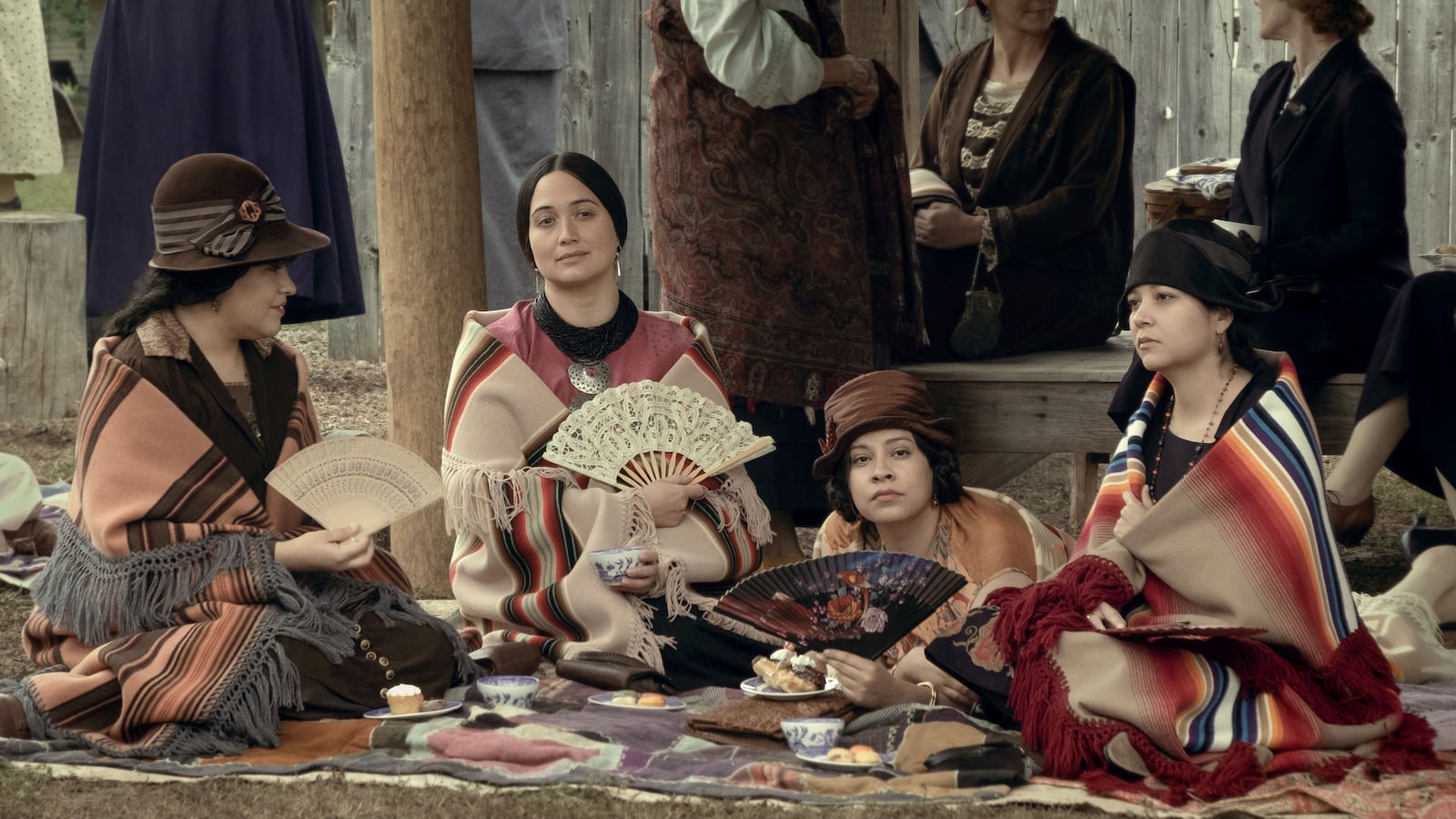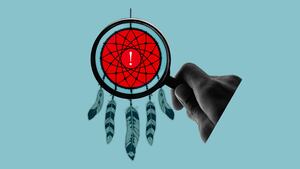It’s the genteel kindness of the white characters in Martin Scorsese’s new film Killers of the Flower Moon that hit me hardest. The ease with which they could both comfort and kill their Osage friends and families. The veneer of love and compassion that masked envy and a disbelief that people they deemed “incompetent” could live better lives than themselves.
The Osage people at the heart of the film persevered against a sustained assault and genocide. They fought to thrive in a world they did not create with rules that were not their own. And yet, they are not at the center of their own story.
Instead, Killers of the Flower Moon is once again told through a white lens, despite concerted efforts by Scorsese and co-screenwriter Eric Roth to incorporate Osage voices. Osage language consultant Christopher Cote, who worked on the film, argued that it would have been better to tell the story through Mollie’s (Lily Gladstone) eyes, but would have needed an Osage director to make that happen. Reservation Dogs star Devery Jacobs recently said that the white characters were portrayed with greater “courtesy and depth” than the Osage characters.
As a citizen of the Chickasaw Nation, I couldn’t agree more.
Killers of the Flower Moon presents an unflinching account of greed and apathy fueled by America’s thirst for oil and the progress that came with it in the early 1900s. Americans replaced their horses with cars, and their candles with electricity powered by oil that improved their lives with the conveniences we take for granted today. And it was Osage men, women, and children who paid for Americans’ newfound prosperity.
The U.S. government deported the Osage people and other Native Americans from their homelands to Oklahoma in the 19th and early 20th centuries to make room for white settlers moving west. The Osage people had no choice but to give up the world they knew and start new lives. They arrived in Oklahoma as the oil-based economy took shape and negotiated terms that enabled them to sell parcels of land while keeping ownership of the minerals beneath them.
The Osage people did not expect to find any oil, let alone end up with the highest per capita wealth in the country. They lived the “American dream” of electric-powered prosperity better than white Americans ever dreamt possible. But white settlers followed the money, devising ruthless schemes to take Osage land and oil for themselves.
This is the world that Killers of the Flower Moon presents its viewers. It is a three-and-a-half-hour barrage of senseless killing masterminded by William Hale (Robert De Niro), a white patriarch who embedded himself within the Osage community. Hale called himself “King of the Osage Hills” and a “true friend” of the Osage people as he planned their deaths. Hale persuaded his nephew Ernest Burkhart (Leonardo DiCaprio) to woo and marry Mollie Kyle (Gladstone), who came from a wealthy Osage family.
More than 60 Osage people, including many members of Mollie’s family, lost their lives to mysterious poisonings or shootings before J. Edgar Hoover’s newly created Bureau of Investigations intervened and brought Hale and others to justice. The devastation of the Osage people was a means to an end, a trade-off the settlers were willing to make.
Long before the movie came to screens, it took a white author, David Grann, to give this story the national profile it deserves in his 2017 book Killers of the Flower Moon: The Osage Murders and the Birth of the FBI. However, Grann wasn’t the first author to tell the Osage people’s story; Chickasaw author Linda Hogan recounted it in her Pulitzer prize-winning book Mean Spirit in 1990, and 15 years later, Osage author Charles H. Red Corn gave his own people a voice in his book A Pipe for February.
Neither of those books caught the attention of Hollywood in the way Grann’s book did. I can only hope the power and success of this film will give Native creators an opportunity to tell their stories to inform, educate, and entertain the wider world.
But more than anything, Killers of the Flower Moon gives audiences a false sense of comfort. It is easy to condemn atrocities that took place a century ago and assure ourselves that we are better people today. However, this story and the moral questions it raises are as pressing for us today as they were then.
As America and the wider world find new engines to power our lives, replacing oil with lithium, cobalt, and other raw elements, again, it is marginalized people who pay the price for progress. In the Democratic Republic of Congo (DRC) “modern-day slaves” scrape the depths of mines to extract the cobalt used in more than 90 percent of the lithium batteries that power our cars. The DRC should be one of the wealthiest countries in the world, a Norway of Africa, but it remains one of the poorest.
Similar devastation is found where the quest for nickel, another vital element for electric car batteries, has destroyed villages and landscapes in Indonesia, Brazil, and other countries. The waste byproducts poison the water, kill food sources, and increase the risks of respiratory disorders and cancers for those living nearby.
Native Americans are also facing the threats of today’s industrial progress. Earlier this year, the U.S. federal government approved what will be the country’s largest lithium mine. Several Native nations objected to development in Thacker Pass, a nine-square-mile region of northern Nevada that they consider sacred land. It was on that same land that U.S. federal agents killed between 30 and 50 Native men, women, and children in 1865. Members of these tribes sued the federal government to stop this development, arguing that they were not sufficiently consulted. They lost their case in July, and development continues.
Killers of the Flower Moon raises painful questions that need urgent answers as we pursue our quest for energy, prosperity, and a sustainable future. No form of energy is truly “clean,” which means that someone will pay an economic, environmental, and social cost for its production. It’s far easier to make trade-offs in the name of progress when those trade-offs are made against people we don’t know in places we don’t see. As these cases show, this means that marginalized people will pay the highest price as others prosper.
We can’t right the wrongs of the past—or the present—without putting those directly affected at the heart of decisions made. They must shape the options available, and they must share in the benefits realized, as the Osage people did when they were forced to Oklahoma. However, they must also be protected with transparency and legal accountability to ensure they retain their rightful benefits and that any development is undertaken with their permission on terms acceptable to them. They, and their world, must be respected as highly as the world of the companies that extract resources or the consumers who drive the cars that their land made possible.
Achieving this will not be easy, but it is essential.






